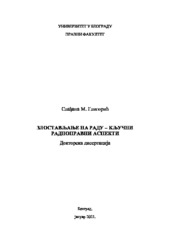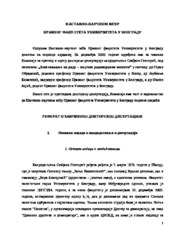Prikaz osnovnih podataka o disertaciji
Злостављање на раду: кључни радноправни аспекти
Harrasment at work : key labour law aspects
| dc.contributor.advisor | Kovačević, Ljubinka | |
| dc.contributor.other | Obradović, Goran | |
| dc.contributor.other | Bojić, Filip | |
| dc.creator | Gligorić, Slađana | |
| dc.date.accessioned | 2021-10-18T11:39:46Z | |
| dc.date.available | 2021-10-18T11:39:46Z | |
| dc.date.issued | 2021-06-03 | |
| dc.identifier.uri | http://eteze.bg.ac.rs/application/showtheses?thesesId=8307 | |
| dc.identifier.uri | https://fedorabg.bg.ac.rs/fedora/get/o:24125/bdef:Content/download | |
| dc.identifier.uri | http://vbs.rs/scripts/cobiss?command=DISPLAY&base=70036&RID=41740809 | |
| dc.identifier.uri | https://nardus.mpn.gov.rs/handle/123456789/18595 | |
| dc.description.abstract | Докторска дисертација по називом „Злостављање на раду – кључни радноправни аспекти“ има за предмет анализу кључних правних аспеката злостављања на раду, с тим што су поред правног, у раду размотрена и психолошка и социолошка обележја овог друштвеног феномена. Посебна пажња посвећена је начинима препознавања и спречавања злостављања на раду, као и правној заштити адресата злостављања на раду. Дефинисање појма злостављања на раду представља тежак и деликатан задатак, посебно када се погледа широка лепеза понашања којима се оно може успостављати, различита перцепција (не)прихватљивости таквих понашања, зависно од друштвенокултурног окружења у ком се предузимају, али и чињенице да не постоји јединствена дефиниција овог појма у стручној и научној литератури и националним законодавствима држава, као ни у изворима права међународног и европског порекла. Изучавајући предмет истраживања, појам злостављања на раду и њему сродне и с њим повезане појмове, ауторка је настојала да идентификује његове битне елементе и карактеристике, које га детерминишу као правни појам, посебно ако се имају у виду различити називи и дефиниције за саму појаву (узнемиравање, малтретирање, виктимизација, мобинг, насиље, психолошки терор и сл.). Поред све комплексности анализе терминолошког одређења појма злостављања на раду и прикладности израза којима се појава описује, спорна је и правна квалификација злостављања на раду и понашања којима се оно успоставља. То су и нека од кључних радноправних питања обухваћених истраживањем. Анализа законских дефиниција злостављања на раду у правима изабраних држава показала је да су најважнији елементи за квалификацију правног појма злостављања на раду понављање одређених радњи и понашања у одређеном временском периоду, којима се угрожавају и вређају достојанство, углед, лични интегритет, професионални интегритет, здравље и положај запосленог, а чиме се ствара непријатељско, увредљиво и понижавајуће радно кружење. Понављање представља критеријум за квалификацију овог појма, који је опште прихваћен у правној теорији и законодавству. И други критеријум вређања одређених заштићених добара адресата злостављања на раду се не доводи у питање у литератури и и судској пракси, док последице злостављања на раду, које се огледају у стварању непријатељског, увредљивог и понижавајућег радног окружења, представљају недовољно одређену и јасну синтагму, чије објашњење ваља тражити у схватањима америчких судова. Критеријум понављања одређених радњи и понашања, као неспорни елемент квалификације правног појма злостављања на раду није прецизно одређен у нашем праву, што ствара проблем приликом тумачења примене меродавних прописа. | sr |
| dc.description.abstract | The doctoral dissertation entitled „Harassment at work - key Labour Law aspects“ aims to analyze the key legal aspects of harassment at work, with the fact that in addition to the legal, the paper also considers psychological and sociological features of this social phenomenon. Special attention is paid to the ways of recognizing and preventing harrasment at work, as well as the legal protection of the addressee of harassment at work. Defining the notion of harassment at work is a difficult and delicate task, especially when looking not only at the wide range of behaviours that can establish it but also different perception of (in) acceptability of such behaviors. This is the result of both the socio-cultural environment in which they are undertaken and the fact that there is no unique definition of this term in the professional and scientific literature, and national legislation of the states, as well as in the sources of law of international and European origin. Studying the subject of research, the notion of harassment at work and its related concepts, the author sought to identify its essential elements and characteristics, which determine it as a legal concept, especially given the different names and definitions of the phenomenon itself (harrassment, victimization, mobbing, violance, psychological terror, etc.). In addition to all the complexity of the analysis of the terminological definition of the notion of harassment at work and the appropriateness of the terms used to decribe the phenomenon, the legal qualification of harassment at work and the behavior by which it is established is also disputable. These are also some of the key labour law issues covered by the research. The analysis of legal definitions of harassment at work in the law of selected states showed that the most important elements for qualifying the legal concept of harassment at work are repetition of certain actions and behaviours in certain period of time, which endanger and insult dignity, reputation, personal integrity, professional integrity, health and the position of the employee, which creates a hostile, offensive and humiliating work environment. Repetition is a criterion for the qualification of this notion, which is generally accepted in legal theory and legislation. The second criterion of insulting certain protected goods of the addressee of harassment at work is not questioned in the literature and court practise, while the consequences of harassment at work, which are reflected in the creation of a hostile, offensive and degrading work environment, are insufficiently defined and clear therefore its explanation should be sought in the perceptions of the American courts. The criterion of repetition of certain actions and behaviours, as an indisputable element of the qualification of the legal concept of the harassment at work, is not precisely defined in our law, which creates a problem when interpreting the application of positive norms and regulations. The minimum duration of acts of harassment at work, which is necessary for the qualification of the legal concept of harassment at work, is not prescribed. In accordance with Lyman's views, in domestic case law and legal theory, the criterion in question is linked to a longer period of time, lasting at least six months, in which the behaviors are frequently repeated. An exception to these understandings of the repetition criteria can be found in the practice of the Social Department of the French Court of Cassation, where the position is affirmed that acts of harassment can be established by activities that take place in a shorter period. | en |
| dc.format | application/pdf | |
| dc.language | sr | |
| dc.publisher | Универзитет у Београду, Правни факултет | sr |
| dc.rights | openAccess | en |
| dc.source | Универзитет у Београду | sr |
| dc.subject | радни однос | sr |
| dc.subject | employment relationship | en |
| dc.subject | harassment at work | en |
| dc.subject | dignity at work | en |
| dc.subject | health and safety at work | en |
| dc.subject | psycho-social risks at work | en |
| dc.subject | prevention of harassment at work | en |
| dc.subject | disputes over harassment at work. | en |
| dc.subject | злостављање на раду | sr |
| dc.subject | достојанство на раду | sr |
| dc.subject | заштита здравља и безбедности на раду | sr |
| dc.subject | психо-социјални ризици на раду | sr |
| dc.subject | спречавање злостављања на раду | sr |
| dc.subject | спорови поводом злостављања на раду. | sr |
| dc.title | Злостављање на раду: кључни радноправни аспекти | sr |
| dc.title.alternative | Harrasment at work : key labour law aspects | en |
| dc.type | doctoralThesis | |
| dc.rights.license | ARR | |
| dcterms.abstract | Ковачевић, Љубинка; Бојић, Филип; Обрадовић, Горан; Глигорић, Слађана; Zlostavljanje na radu: ključni radnopravni aspekti; | |
| dc.identifier.fulltext | https://nardus.mpn.gov.rs/bitstream/id/76642/Izvestaj_Komisije_11520.pdf | |
| dc.identifier.fulltext | https://nardus.mpn.gov.rs/bitstream/id/76641/Disertacija_11520.pdf | |
| dc.identifier.rcub | https://hdl.handle.net/21.15107/rcub_nardus_18595 |



